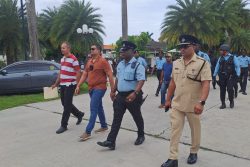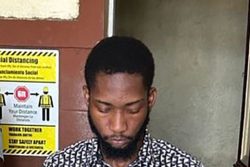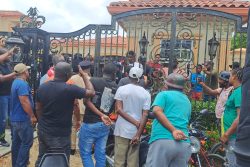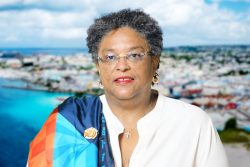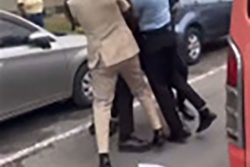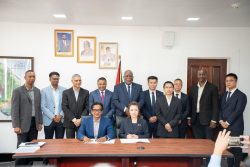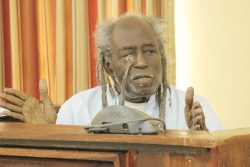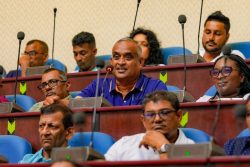Dear Editor,
We have written on COVID-19 related matters to share information with your readers on issues of concern with this global pandemic. At the national level, we refer to the situation as a country specific epidemic. We usually turn to, and depend on, the media, particularly the newspapers, and their online versions, as the first, best and undisputed source of information. In that way, information about what to do in preparation prior to, during and after an outbreak, as well as both the positive and negative associated developmental issues, are somewhat allayed. A few years ago, in Guyana, the radio was probably the main source of information in many communities in the interior. Today, cellular communication and the internet have replaced the role of the radio in disseminating news that is either true and trustworthy, or indefensibly false. Indeed, we feel that stories of and threats from, COVID-19 amongst the Amerindian population need retelling and to be placed into perspective.
The press reported on April 22, 2020 that Toshao Orin Fernandes, of the Indigenous village at Chinese Landing in Moruca, sub-district of Region 1, who, fearing the possible spread of COVID-19 in his community, sent a letter to the de facto Minister of Public Health, seeking her aid to put a halt to gold mining activities in that area. They were reportedly unable to stop the movement of outsiders to the village; mining being regarded as an essential service. What makes this even worse is that mining was being carried out on titled land in the village without any permission from the village council; permission was seemingly granted by an individual who claims he has jurisdiction over the land, but with whom the community has been in a longstanding dispute.
In the letter he sent, Toshao Fernandes related that every day the community was forced to look “helplessly at people coming into the village, setting up shops and working dredges and pumps. There are no gates to the village and people from all walks of life continue to arrive in the village. He pointed out that the greatest threat for the residents was the limited medical personnel to administer emergency care”. He was of the opinion that “the risk of someone in the village contracting COVID-19 is relatively high due to the free movement” and concluded that “on behalf of my people, I most urgently seek your immediate intervention into this situation.” He had every right to complain as the updated government emergency measures included a clause stipulating that where a Village Council had determined that a public health threat exists, in relation to any mining or forestry operation carried out as an essential service, it can recommend to the Minister that the operation be discontinued.
Michael McGarrell, a specialist and Forest Policy Officer and representative of the Amerindian People’s Association’s (APA) Geographic Information System, warned that Guyana’s indigenous communities were at risk of potentially devastating consequences if COVID-19 makes its way into any one of them. He stated that the indigenous communities have limited access to medical supplies and care, including medical resources such as personal protective equipment (PPE) or equipment such as ventilators to respond to a potential outbreak and that “there were still high volumes of persons traveling and engaging in social activities that did not go hand in hand with social distancing”. He also pointed out that some communities have been doing screening but there was need from a policy level on what is to be done’.
Those appeals from Moruca, were reported on April 22, 2020 and though not privy to the response to the request, we are now aware that on Independence Day, 26 May, 2020, Moruca‘s first COVID-19 case was traced back to Lethem (Rupununi). As a result, one person had died, and several others are now in isolation/quarantine since Moruca, Region 1, North West District (NWD) recorded its first case. It was reported in the press that a 59 year old male, Mr. Vincent Torres, a former teacher and assistant returning officer of the Guyana Elections Commission, turned up at the district hospital with complaints of breathing problems, resembling those associated with COVID-19. His condition worsened before his results came back and he died suddenly while receiving treatment. Post-mortem results later officially confirmed that Mr. Torres had died from coronavirus, increasing the number of deaths to 11 in the country.
Dr. Derron Moonsammy, who is in charge of the Kumaka-Moruca District Hospital, reported that a mobile testing unit from Georgetown was expected to arrive in Moruca to conduct more testing but feared that it would be a great challenge to contain the disease in his district. He explained that Moruca is a relatively large district consisting of many villages miles apart and with many secret trails.
Another report from Dr. Nial Uthman, Regional Health Officer, Upper Takutu-Upper Essequibo (Region Nine) stated there were 2 new cases in that area known as the Rupununi. The number of cases is increasing daily, is now at 137 cases in the country with 11 deaths so far, of just over 1500 tested for the virus, but reports of the spread of the epidemic in the entire country, have only just begun. We are unaware if all of those were diagnosed using the gold-standard RT-PCR (Reverse Transcript-Polymerase Chain Reaction), given that there is some doubt as to the accuracy of the IgM and IgG tests. News reports now confirm that there are now 12 cases at the Palms Geriatric Home, of which the first case prompted us to contribute to the press. We understand that only 50% of the residents there have so far been tested.
We have had weeks to plan for the disaster which began in Georgetown last March and is now unfolding in the interior of the country. An effective response depends on advanced planning. Without planning, to quote from ‘The public health consequences of disasters’ edited by Eric K. Noji, “in the midst of the crisis, a number of questions go unanswered. For example, what groups will respond to the acute needs of survivors? What training do they have or need? What are their specific responsibilities? What are the priorities for service delivery, in terms of laboratory equipment and supplies?”
When we hear of eleven COVID related deaths in Guyana, our tendency is to casually dismiss their significance as we are not personally affected, and it is just another (small and insignificant) number. When we read of those who have survived the disease begging us to take it seriously, we are not moved by their pleas, it is somebody looking for attention. We only arise from our slumber when we know someone who is in the Intensive Care Unit and will either die or survive; or when someone is in quarantine as a result of exposure, worried and pensive, as they wait to hear if he or she was positive.
We need to think of families, such as those of 59-year-old Vincent Torres and of those 10 other families, who clearly have different support needs from those in the general population. In addition to physical, economic, and emotional loss they suffer, they must also cope with the grief that attends the death of a loved one. A bereaved family member may feel guilty for causing or failing to prevent the death. When so much media attention is devoted to giving thoughts for those who survived and asserting how “it could have been so much worse”, for those who lose loved ones to COVID, it is already much worse in every respect. Though we haven’t yet seen it appear on the market, don’t be surprised if we see people selling T-shirts proclaiming “I survived COVID-19”, which will only serve to remind us of the loss of one who did not survive.
Lost in all of this are, and hardly ever emphasized, the psychological consequences of the critical part of disaster preparedness even when plans to deal with other issues are in place. A person’s efforts to resume a normal life are supported by the offer of assistance and information at a time and in a manner appropriate to his or her experience, education, ethnicity and for that matter, language.
We have seen the disease spread from Georgetown, south to the Rupununi, Region 9 and then back up north to Moruca, Region 1. While we have been concentrating in Georgetown, the much touted epicentre of the disease, we have not used the opportunity to plan, prevent the spread, and organize development of health provisions in the rest of the country, as requested by the Toshao, doctors and health workers in Regions 1 and 9.
The National COVID-19 Task Force, we understand, is dealing with specific tasks such as deciding whether to install more tables for counting of votes at the Conference Centre instead of dealing with the epidemic which is spreading over the land. We gather that the task force supplied guidelines on April 21, 2020 for operations at the Arthur Chung Conference Centre on its initial request for 10 workstations during the election recount. Coincidentally that was the day prior to Toshao Orin Fernandes’ request to the Minister of Public Health, who we gather is also a member of the National Corona Virus Task Force, for a closure of Region 1. We suggest that the National Task Force should be dealing with issues such as those in Regions 1 (the Northwest) and 9 (in the South, Rupununi) already highlighted. It is our opinion that the Task Force should be concentrating on how many testing facilities have been established and how many tests are available, if they are PCR, how are they being maintained at the specific temperature and how they are being transported immediately to a specific laboratory for analysis? Where have those laboratories been established and are there greater needs? What are the plans for their establishment? The press reports that a laboratory was established at Port Mourant (Region 6) two days ago, on May 28, 2020. What one must ask is being done when a patient’s is test positive, and does everyone know what and where are isolation/quarantine centres?
It has been reported that those returning from overseas can pay for their stay at specific hotels. Questions remain on whether the owners/persons with responsibility for these hotels have been trained to properly carry out and maintain sanitary conditions in the facility, to prevent further spread of the disease at these hotels? We read in the press on the May 26, 2020, of doctors kicking down a door at the Isolation Unit at the Diamond Hospital, after expressions of frustration by COVID-19 patients. We can only but conclude that there are no guidelines, and if there are, they are not understood nor practiced.
Implementing measures to contain the disease connotes the availability of financial and human resources which Guyana can find, but there are examples of simple steps that we can take to prevent the spread of, if not contain, the disease. There are three stages to stopping the spread of this virus – Masking, Testing and Vaccination.
We must devote adequate resources to enable more tests to be done especially in the epicentres around the country. Let us add contact tracing too to this effort. Accuracy in reporting data is paramount as it will enable us to wisely allocate available resources as we move to curb the spread of the disease.
As a result of gold mining, 35 years ago, we had reported the spread of P. falciparum malaria from Region 9 (Rupununi) to Region 1 (Northwest) as we now see with COVID-19, whilst Indal Rambajan reported an outbreak of the same parasite after a 28 year absence from the Cuyuni, Mazaruni, Potaro (Region 7). At that time, Dr. Winston Gobin, Director of Regional Health Services said, ‘to declare a national emergency means you will bring in extra resources’, referring to equipment and supplies to deal with the outbreak. We are sure there are those in Guyana who could be invited to join the Task Force as they have objective views and can make meaningful contributions.
We must do more now to contain the virus for if not, and whether the final count of the election results in a new/incumbent government, the harsh reality on the ground will remain the same.
Yours faithfully,
Keith H. Carter, MD
Raj. N. Mungol, MA
Bhiro Harry, MD
Pedro Pons, MD
